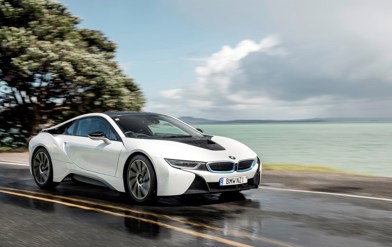McLaren has finally revealed its $1.5m, 588kW addition to the top-tier Ultimate Series, heralded as the brand's 'most extreme road car yet.'
Originally referred to as P15 during development and testing, McLaren has chosen to name its latest creation after legendary Formula 1 driver Ayrton Senna, who won all three drivers titles with the team.
The Senna name has not been used lightly. Unlike all other McLaren models to date, the McLaren Senna adopts a 'form-follows-function' design philosophy with a single-minded purpose - to be the ultimate track-focused McLaren with number plates.
The Senna is the lightest McLaren since the F1 of the 90s, features has the most power internal combustion McLaren has ever built and aggressive styling molded in the pursuit of maximum aerodynamic efficiency and downforce.

While the McLaren Senna is not a direct replacement to the P1 - currently the only model in McLaren's Ultimate Series - the new model will sit alongside the hybrid hypercar along with an upcoming three-seater codenamed BP23.
The car's unique appearance is largely due to newly-developed front and rear active aerodynamics components 'clipped' onto the teardrop shaped body. A large front splitter up front channels air over, through and under the car, passing vented wheel arches, scoops, inlets and massive rear wing. Both the front splitter and rear wing feature active elements.
'You cannot follow a single line from the front to the rear without it passing through a functional air intake or vent,' says McLaren.
The double-element rear wing is 1,219mm tall at its highest when the car is stationary. Hydraulically actuated, the wing constantly adjusts to optimise downforce and aerodynamic balance, as well as functioning as an airbrake under heavy braking.

A large double diffuser in the rear is made from a single piece of carbon fibre, creating a low-pressure zone that sucks the car to the ground.
‘Gurney’ flaps ahead of a stepped louvres direct air away from the rear deck and down the sides of the body creating an area of low pressure that draws hot air out from the radiators and engine bay for better cooling.
McLaren's carbon fibre Monocage III chassis forms the core of the McLaren Senna, a development of the structure used in the 720S and the strongest monocoque ever built by McLaren for a road-legal vehicle. Every body panel is made from carbon fibre resulting in a dry weight of 1,198kg.
Power comes by way of the most powerful internal combustion engine ever created by McLaren, a dry sump, flat-plane 4.0-litre twin-turbocharged V8 engine. Codenamed M840TR, the new engines delivers 588kW and 800Nm of torque. Lightweight internal components reduce mass and combine with low inertia twin-scroll turbochargers and electronically controlled wastegates.

A dual-clutch seven-speed gearbox delivers power to the rear wheels, controlled with elongated carbon fibre shift paddles designed to be used with or without racing gloves.
The engine and transmission can be tailored with different driver modes - Comfort, Sport or Track - but whatever you chose, McLaren say performance will remain 'suitably savage.'
McLaren hasn't released any official performance details yet, with the brand holding back all official performance figures until January.
Senna will feature the brand's RaceActive Chassis Control II double-wishbone suspension system with hydraulically interconnected dampers and anti-roll bars that work with the front and rear active aerodynamics in the corners and on straights.
The braking are carbon ceramic discs with with bespoke Pirelli P Zero Trofeo R tyres developed specifically for race track and road use. For performance reasons, only one wheel style is available: an ultra-lightweight alloy wheel with a centre lock system.

The McLaren Senna features F1-inspired dihedral doors opening with a portion of the roof to allow drivers or passengers to enter, even when wearing a helmet and a race suit.
The doors feature two-piece glass side windows with a fixed top part and a smaller opening section below. Both the door upper (effectively part of the roof) and the lower half of the door side can be specified with glass as a replacement for the carbon fibre panels. To accommodate the door design, the release mechanisms and window switches are housed alongside the engine start button above the driver’s head.
Visual carbon fibre is used extensively in the cabin. Dependent on customer preference, seats can be finished in alcantara or leather. Driver controls have been deliberately kept to a minimum to reduce clutter and there was never any consideration given to baggage space in the cabin, apart from a small space behind the seats for two helmets. One of the only luxuries is the high-definition McLaren Folding Driver Display and central infotainment screen.
One of the best interior features is the roof-mounted 'snorkel' intake that funnels rushing air and engine noise into the cabin. For added theater, engine sounds are also transferred into the cockpit through unique engine mounts, amplified through the carbon fibre Monocage chassis.

“The McLaren Senna is a car like no other: the personification of McLaren’s motorsport DNA, legalised for road use but designed and developed from the outset to excel on a circuit," said McLaren CEO Mike Flewitt.
"Every element of this new Ultimate Series McLaren has an uncompromised performance focus, honed to ensure the purest possible connection between driver and machine and deliver the ultimate track driving experience in the way that only a McLaren can.”
The McLaren Senna will be hand-assembled in England at the McLaren Production Centre in Q3, 2018. Production will be limited to 500 vehicles, each costing from £750,000 (NZ$1.5 million) and all have already allocated to customers.
The McLaren Senna will make its public debut in March at the Geneva International Motor Show.




























